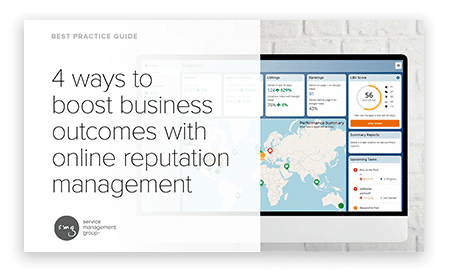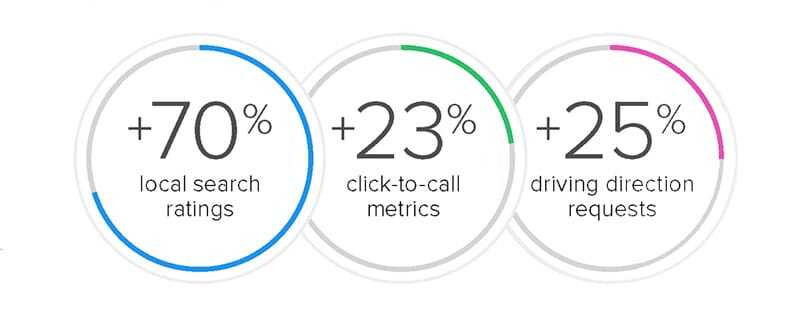Manage your online reputation to boost business outcomes
Published on May 10, 2022

In today's world, customers are thoroughly plugged in, and most online conversations are likely to be about your brand, not with it. Research indicates 97% of people read online reviews of local businesses and take them into account when making decisions. People can be quick to share with the online community what is on their mind without filters so it’s imperative you have a way to be part of the conversation.
Why online reputation management matters
Unfortunately, this cannot be a one-time or occasional action. 64% of consumers also say they’re more likely to buy a product with fewer, more recent reviews than if there is a higher volume of reviews published three or more months ago. This means you must be continuously engaged to maintain relevancy and help drive the online narrative.
Consumers rely on online reviews to make decisions
Whether you are engaged or not, your customers are talking to each other through online reviews and are constantly researching your brand, products, and services. If you don’t have a plan to actively manage your online reputation, you leave yourself at the mercy of a conversation you have no visibility to that can potentially go a million different ways.
For modern brands, listening to the online customer voice through online reputation management is a key strategy for taking advantage of the opportunity to turn the potential liability of negative feedback from untamed internet opinions into a tool for increasing customer traffic, improving loyalty, and driving positive business outcomes.

How online reputation management can boost business outcomes
Here are the basics of how to manage your online reputation, why it’s necessary, and how it can help make a significant difference for your customers and your organization.
How to audit and improve your online reputation
Online reputation management is the active monitoring of online activity talking about your brand and applying strategies to create more positive mentions and fewer negative examples of feedback. A complete strategy involves addressing several core concerns:
- Are customers finding you? – How are you ranking in search engine placement and how is that driving customer traffic?
- What are consumers saying about you? – A complete program looks at both nationwide and location-level unsolicited feedback from sources like Google, Yelp reviews, and key social media platforms.
- What are you saying to customers? – You don’t just want to know what people are saying about your business; you want an opportunity to make it better. Responding to customers on a personal basis allows you to not only recapture business, but to collect further feedback to continue to work towards building the best experience possible.
The online data collection needed to do this work involves pulling information from extremely disparate sources from across your online presence, so while the overall strategy is guided by organizations, the actual collection data management is done through a service or partner that facilitates the data collection, reporting, and response method through a suite of online capabilities around the following key topics:
Review sentiment analysis by combining data sources
Unsolicited ratings + reviews are only one piece of the puzzle. When combined with feedback from in-store + digital visits, contact centers, employee feedback, and other sources, you can begin to put together a more complete picture of customer sentiment around your online image and how channels are impacting one another. Without a broader listening and action strategy, ratings + reviews are just one key piece of the puzzle.
Connect ratings and reviews with CX data
Many brands collect structured CX survey data to analyze measurable aspects of a customer’s interaction with the brand. Collecting this quantitative feedback is a vital part of understanding a brand’s overall performance both brand-wide and at the location level.
Unsolicited social ratings and reviews significantly enrich context on the customer experience—sharing insight on parts of the interaction that perhaps isn’t covered in solicited feedback and potentially offering an alternate view of the experience.
Brands with a combined solution to find insights from both CX data and an online reputation management solution know how they stack up against competitors, armed with insight to drive meaningful change and rise to the top of their industry. They can quantify ROI by demonstrating the connection between customer experience and sales growth. And, most importantly, they can easily engage with customers—resolving their issues, building stronger customer relationships, and increasing business volume without wasting time navigating multiple channels.
Engage with customers through ratings and reviews
Customers are leaving reviews about your brand on the major review sites like Yelp and Google, but that doesn’t have to make it a one-sided conversation. Effective reputation management tools aggregate location-specific ratings and reviews across the top review sites to provide brands with a robust tool for social engagement, not just listening. An effective system also facilities review management, allowing you to improve your brand image by responding to reviews from a central platform.
To help make data easier to decipher, analytic reports and data visualizations help keep a pulse on where to focus so you can make meaningful changes to the customer experience. Utilizing these reports can help you:
- Track reviews over time
- See where your customers are leaving reviews
- Compare the performance of different locations
- Understand the effect of reputation management efforts
- Track conversations from Google My Business data
Monitor performance at the location level
Aggregating information from your online reputation management program gives you an immediate high-level overview of your ratings from an array of online sources, helping you stay informed of your brand’s overall perception. But many reputation management solutions stop at the brand level, which doesn’t give you competitive insights to succeed on the local level.
Location-level monitoring and comparing with competitors through benchmarking can give you insights into competitors’ performance, visibility into location- and brand-level information on how customers interact with your online listings, local brand visibility, and more. This extra level of data provides a boost of insights into customer behavior and brand management to significantly help your online presence.
Measure the business impact of reputation management
The metric of success for any program is in how well it drives business and delivers an ROI, and managing your online reputation is no different. With the sizable impact ratings and reviews have on influencing a customer’s buying decisions both positively or negatively, the potential for upside is huge.
Here are three key ways managing your online reputation can drive business outcomes:
1. Increase visibility through higher SEO rankings
When it comes to the Google search game, the only way to win is to rank as high as possible. 93% of searchers never go past the first page, instead using only the first 10 search results to form their impression. And what gets you on that first page? Engagement. When Google sees you’re responding to customers, they’ll reward you with a nudge to the top—which leads to more clicks, higher traffic, and ultimately, increased purchase rates.
After the first 12 months of tracking and responding to customer reviews, brands that implement and engage with a comprehensive online reputation management system typically see increased SEO, more favorable search engine placement, and greater mobile engagement. Other improved metrics include:

By increasing these metrics, brands can demonstrate the customer experience directly corresponds with real business results.
2. Build customer trust and loyalty
41% of consumers say when brands reply to reviews, it shows the company really cares about their customers. Why is that so important? Because if consumers don’t trust you, they won’t buy from you.
The level of consumer trust that makes a difference in driving credibility is not always an easy thing to get. When consumers are evaluating a brand, they’re looking at 10 reviews on average before trust is established.
By having a ratings + reviews solution that does the heavy lifting for you—with an in-platform response system, competitive benchmarking, and intuitive trend reporting—brands are able to connect with more customers in a more timely way. This kind of positive impression is what drives brand loyalty and keeps customers coming back.
3. Have a crisis plan to address negative events
Accidents and emergencies happen, and news of high-impact, low-frequency events like food safety problems can travel fast and cause a public relations nightmare. A discrete but significant part of online reputation management is the capability to quickly and accurately identify and report negative content around certain triggering events, like pests or food safety. These allow you to take immediate action both with the customer and the location to address the problem.
An optimized program also allows you to proactively plan for addressing customer problems and negative reviews. Pre-load crisis mitigation by setting real-time, role-based alerts to notify key team members or reviews with specific star ratings or comments containing keywords and respond to comments. Responses can be sent either individually or in bulk with personalized, scripted response templates equipped with dynamic tagging.
Intuitive brand management technology—that works in conjunction with your customer experience management program—makes it easier to pinpoint customer issues and correct their problems faster. Best-in-class technology will provide real-time, rule-based alerts, which means you can be notified immediately about reviews with specific star ratings or comments containing keywords.
This is incredibly important because resolving a customer complaint isn’t just high stakes—it’s also a great opportunity. Customers who are highly satisfied with problem resolution are more likely to return than those with no reported problems at all.
Take a proactive approach to online reputation management
Taking an active role in managing your online reputation is a high-stakes game for brands who need to stay ahead of online conversations. By taking a proactive approach to engage with unsolicited online activity, brands can not only improve perceptions, but drive more website traffic, reclaim business, and develop insights that lead to operational improvements.
Related articles

How Can Ratings + Reviews be Leveraged to Increase Revenue and Prove ROI?
In today’s digital world, one of the most impactful ways to boost business outcomes and quantify ROI is through an effective and efficient online reputation management solution. The financial impact r

How Social Media Listening Can Increase Customer Advocacy
Social media listening is a continuous stream of unfiltered feedback, both good and bad, from the customer to you. Here is how to use it to increase customer advocacy.

Automotive Reputation Management: A Quick-Start Guide on Navigating Online Reviews
With the right automotive reputation management, your brand can optimize online ratings and reviews to drive engagement and brand advocacy. Here's how: